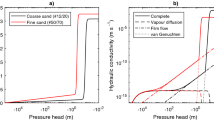Abstract
Mathematical methods for description of the processes of evaporation from the soil surface under conditions of the sub-arid zone of the south of Russia are discussed. Theoretical studies in this area and the results of their practical application have been analyzed. Natural observations are explained using mathematical modeling. Mathematical models of evaporation from the soil surface are divided into two types: physico-mathematical, which are based on the interaction between the water and the soil carcass, and phenomenological, which are based on balance ratios. The data on the evaporation from the surfaces of light soils have been analyzed with allowance for the diffusive and film transfer of moisture within the pore space. The cumulative evaporation from extended areas has been analyzed using a semi-empirical model, which connected evaporation intensity with the precipitation and the hydrophysical state of the soil moisture in the aeration zone. Good agreement between the theory of the capillary transfer of moisture and the data on the evaporation from the surface of open sandy soils has been revealed. A nonlinear relationship between the evaporation rate and the depth of the underlying surface, as well as the capillary-sorption pressure, has been revealed. The amount of annual precipitation in the south of Russia and the cumulative evaporation are associated with each other via a power dependence indicating the capillary-sorption nature of the evaporation.




Similar content being viewed by others
Notes
WP, wilting point; FMC, field moisture capacity.
REFERENCES
Aver’yanov, S.F., Dependence of water permeability of soils on air content, Dokl. Akad. Nauk SSSR, 1949, vol. 69, no. 2, pp. 142–144.
Bittelli, M., Ventura, R., Gaylon, S., Campbell, G.S., Snyder, R.L., Gallegati, R., Pisa, P.R., Coupling of heat, water vapor, and liquid water fluxes to compute evaporation in bare soils, J. Hydrol., 2008, pp. 191–205.
Budagovskii, A.I., Evaporation of soil waters, in Fizika pochvennykh vod (Physics of Soil Waters), Moscow: Nauka, 1981, pp. 13–95.
Cheremisinov, A.A., Environmental sustainability of the irrigated system, Aktual’nye Napravleniya Nauchnykh Issledovanii XXI Veka: Teoriya i Praktika, 2014, vol. 2, nos. 3–4 (8–4), pp. 494–498.
Churaev, N.V., Moisture transfer mechanism in capillary-porous bodies, Dokl. Akad. Nauk SSSR, 1963, pp. 1361–1364.
Davydov, L.K., Vodonosnost’ rek SSSR, ee vliyaniya i vliyanie na nee fiziko-geograficheskikh faktorov (The Water Content of the Rivers of the USSR, Its Influence and the Influence of Physical and Geographical Factors on It), Leningrad: Gidrometizdat, 1947.
Deryagin, B.V., Nerpin, S.V., and Churaev, N.V., On the theory of liquid evaporation from capillaries, Kolloidn. Zh., 1964, vol. 26, no. 3, pp. 301–307.
Dmitriev, S.I., Some patterns of moisture evaporation in the pores of the soil, Trudy Leningradskogo Gidrometeorologicheskogo Instituta, 1964, no. 26, pp. 214–231.
Gel’fan, A.N., Dinamiko-stakhosticheskoe modelirovanie formirovaniya talogo stoka (Dynamic-Stochastic Modeling of Melt Runoff Formation), Moscow: Nauka, 2007.
Grifoll, J., Gasto, J.M., and Cohen, Y., Non-isothermal soil water transport and evaporation, Adv. Water Resour., 2005, vol. 28, no. 11, pp. 1254–1266.
Konstantinov, A.R., Isparenie v prirode (Evaporation in Nature), Leningrad: Gidrometeoizdat, 1968.
Korolev, V.A. and Bludushkina, L.B., Relationship between the water potentials in soils and the parameters of water evaporation from them, Inzh. Geol., 2013, no. 3, pp. 22–33.
Kulik, N.F., Vodnyi rezhim peskov aridnoi zony (Water Regime of the Arid Zone Sands), Leningrad: Gidrometeoizdat, 1979.
Lebedev, A.V., Metody izucheniya balansa gruntovykh vod (Methods for Studying the Balance of Groundwater), Moscow: Nedra, 1976.
Lykov, A.V., Teoriya sushki (Drying Theory), Moscow: Energiya, 1968.
Nazari, M., Chaichi, M.R., Kamel, H., Grismer, M., and Sadeghi, S.M.M., Evaluation of estimation methods for monthly reference evapotranspiration in arid climates, Arid Ecosyst., 2020, vol. 10, no. 4, pp. 329–336.
Nerpin, S.V. and Chudnovskii, A.F., Fizika pochv (Physics of Soils), Moscow: Nauka, 1967.
Nerpin, S.V. and Chudnovskii, A.F., Energo- i massoobmen v sisteme rastenie-pochva-vozdukh (Energy and Mass Transfer in the Plant-Soil-Air System), Leningrad: Gidrometeoizdat, 1975.
Panina, S.S. and Shein, E.V., Mathematical models of soil moisture transfer: importance of the model’s experimental assurance and the upper boundary condition, Vestn. Mosk. Univ., Ser. 17: Pochvoved., 2014, no. 3, pp. 45–50.
Salugin, A.N. and Kulik, A.K., Hydrophysical characteristics of sand soils: Modeling of restoration of water-content ability, Ross. S-kh. Nauka, 2017, no. 6, pp. 51–55.
Salugin, A.N., Kulik, A.K., and Vlasenko, M.V., On the issue of water resistance of unsaturated soils in arid zone, Ross. S-kh. Nauka, 2017, no. 1, pp. 21–24.
Salugin, A.N., Kulik, A.K., and Vlasenko, M.V., Dynamics of elements of water balance in models of soil hydrological processes, Ross. S-kh. Nauka, 2018, no. 3, pp. 47–50.
Schaap, M.G., Leij, F.J., and Van Genuchten, M.Th., ROSETTA: A computer program for estimating soil hydraulic parameters with hierarchical pedotransfer functions, J. Hydrol., 2001, vol. 251, pp. 163–176.
Shein, E.V., Kurs fiziki pochv (Soil Physics Course), Moscow: Mosk. Gos. Univ., 2005.
Simunek, J., Van Genuchten, M.Th., Sejna, M., Development and applications of the HYDRUS and STANMOD software packages and related codes, Vadose Zone J., 2007, vol. 7, no. 2, pp. 587–600.
Van Genuchten, M.Th., A closed-form equation for predicting the hydraulic conductivity of unsaturated soils, Soil Sci. Soc. Am. J., 1980, vol. 44, no. 5, pp. 892–898.
Voronin, A.D., Energy concept of the physical state of soils, Pochvovedenie, 1990, no. 5, pp. 7–19.
Funding
The study was performed within the framework of the State Assignment no. 122020100450-9 “Development of a new methodology for the optimal management of bioresources in the agrolandscapes of the arid zone of Russian Federation using a system and dynamical modeling of soil and hydrogeological processes and a complex evaluation of the effect of climatic changes and anthropogenic loads on the agrobiological potential and forest conditions.”
Author information
Authors and Affiliations
Corresponding author
Ethics declarations
Conflict of interest. The authors declare that they have no conflict of interest.
Statement of the welfare of animals. This article does not contain any studies with animals performed by any of the authors.
Additional information
Translated by N. Statsyuk
Rights and permissions
About this article
Cite this article
Salugin, A.N. Modeling the Evaporation Process. Arid Ecosyst 13, 133–139 (2023). https://doi.org/10.1134/S2079096123020129
Received:
Revised:
Accepted:
Published:
Issue Date:
DOI: https://doi.org/10.1134/S2079096123020129



